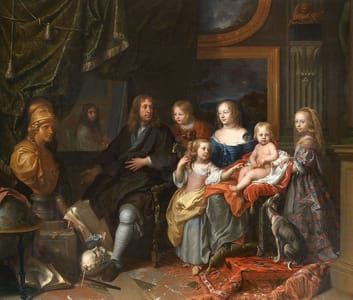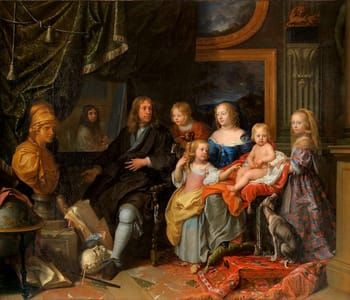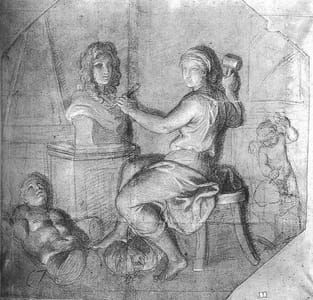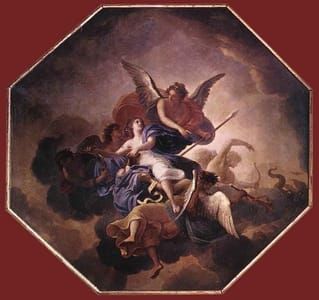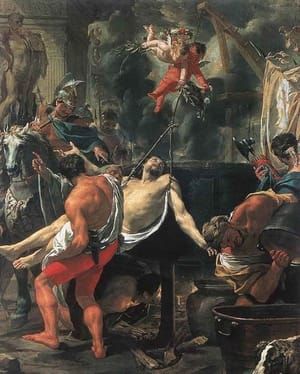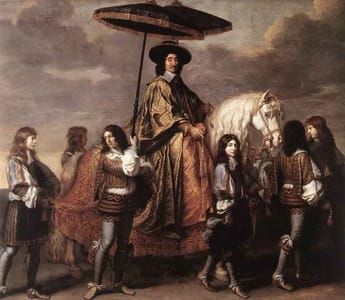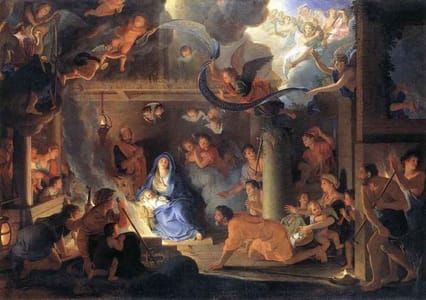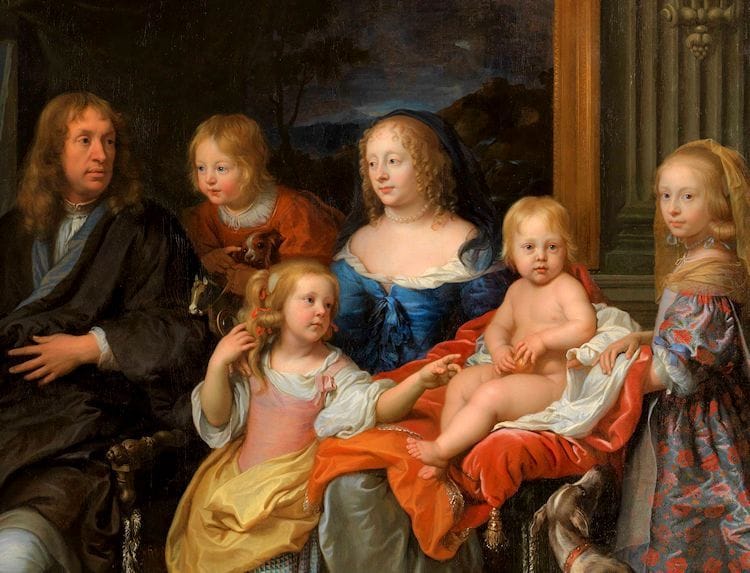

Everhard Jabach and His Family, 1660
Charles Le Brun
This painting combines the domestic intimacy and descriptive richness of Dutch and Flemish art, which Jabach collected and admired, with the measured formal organization and allegorical allusions characteristic of French portraiture. Everhard Jabach (1618–1695), dressed in black, is seated in the company of his wife, Anna Maria de Groote (died 1701), and their four children (from left to right): Everhard the Younger (1656–1721), Hélène (1654–1701), Heinrich (1658–1703), and Anna Maria (1649–1706). Although Le Brun presents an arresting portrayal of each sitter, much of the composition is given over to Jabach and the emblems of his cultural interests and, through the artist’s reflection in the mirror, his association with France’s leading painter. To judge from the ages of the children, Le Brun’s canvas must have been executed around 1660, which also coincides with the construction of his grand new Parisian house, for which this painting was commissioned.
This magnificent painting by the leading painter of King Louis XIV (1638–1715)—the artist who supervised the decoration of the Louvre and Versailles and headed the Gobelins manufactory for tapestries and furniture—is a landmark in the history of French portraiture. It depicts the family of a major figure in the world of finance who was also one of the most important collector-merchants in seventeenth-century Europe. Given the importance of the artist and sitter as well as the detailed description of the setting and the inclusion of the artist’s self-portrait, it constitutes a defining work of art and a key document in the cultural and political history of 17th-century France.
A large damask curtain is theatrically drawn back to reveal a richly appointed interior—presumably a room in the Hôtel Jabach in Paris.... A pet whippet seated on an Ushak carpet of unusual design... looks up adoringly to the marvelous and striking figure of Anna Maria, who is richly dressed in a flowered brocade and wears a string of blue beads; strands of hair on both sides of her face are tied with blue ribbons. She lovingly attends to her infant brother, who is posed proudly on a velvet cushion. Jabach, watched by his adoring son and heir, gestures with his right hand towards an assemblage of objects symbolizing his cultural interests: a Bible, an open copy of Sebastiano Serlio’s architectural treatise, a porte crayon with three colors of chalk (a preliminary study in the Louvre for Heinrich, which... is, in fact, drawn in three colors), a rolled drawing of a head, an ancient marble bust of a philosopher, a compass and measuring stick, a book (for literature and poetry), and a celestial globe (for astronomy, conceivably by the famous Dutch maker Willem Jansz Blaeu. The volume of Serlio is open to the chapter on geometry and shows illustrations for a pyramidal plane angle (inscribed "Ango / lo piano"), a rhombus ("Rhombo"), an illustration for measuring an irregular shaped area by reducing it to triangles and rectangles ("Forma de diversi & ine / quali lati"), and a method for enlarging a square to whatever dimensions might be necessary.... Most prominent among these objects is the bust of Minerva, goddess of wisdom and the arts. She is identified by her distinctive helmet, which is decorated with a ram’s head, and by the Medusa on her breastplate. Whether Le Brun reproduced an actual bust or freely invented one cannot be said with certainty.... Propped behind Jabach is a black-framed mirror in which is reflected Le Brun himself, at work on a canvas. The picture thus becomes a testament to the close relations of patron and artist as well as a sort of allegory of painting. There is an obvious analogy with Velázquez’s Las Meninas (1657; Museo del Prado, Madrid), painted only a few years earlier. The furnishings of the room are an important document of a particularly prestigious interior. The back wall is decorated with two superimposed landscapes in gilded frames—one circular, the other rectangular; the circular one depicts a storm while the rectangular one shows a calm, thus introducing the theme of the contrasting moods of Nature, perhaps inspired by Poussin's two canvases of 1651 for the Parisian collector Jean Pointel.... Atop a marble bracket is a gilded bronze group by the Florentine sculptor Antonio Susini of a lion attacking a horse, a version of the celebrated ancient marble group of the same subject on the Campidoglio in Rome. An unidentified Roman marble sculpture is visible behind the column on the right of the composition. The two landscapes decorating the wall are of a type often associated with Gaspard Dughet but also show affinities with the work of Francisque Millet, who would only have been eighteen at the time, but whose work Jabach admired.... On the opposite wall, reflected in the mirror, is a cast of a famous ancient relief, the Borghese dancers, one of the most admired works of ancient art... It is worth pointing out that half the composition is given over to Jabach, the emblems of his cultural interests, and the mirror with Le Brun’s reflection, while the other half is occupied by his family. His gesture towards the books and objects around the bust of Minerva is counterbalanced by the turn of his head towards his wife. In this way, the portrait at once alludes to the importance of Jabach’s intellectual pursuits and his affection for his family. It is his young heir, leaning forward eagerly, who bridges these two worlds. The composition combines the domestic intimacy and descriptive richness of Dutch painting, which Jabach greatly admired, and the elegant formal organization and allegorical allusions characteristic of French art.
(http://www.metmuseum.org/art/collection/search/626692)
Uploaded on by Suzan Hamer
Charles Le Brun
artistArthur
Wait what?
